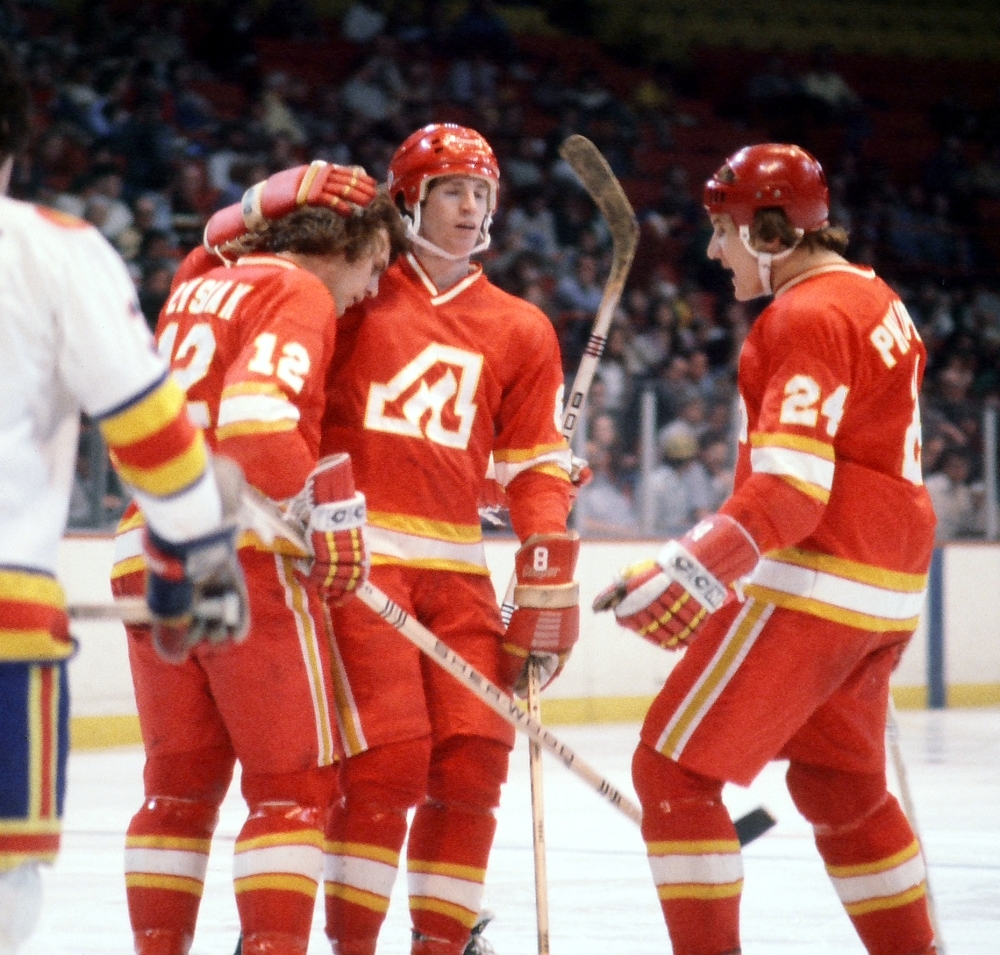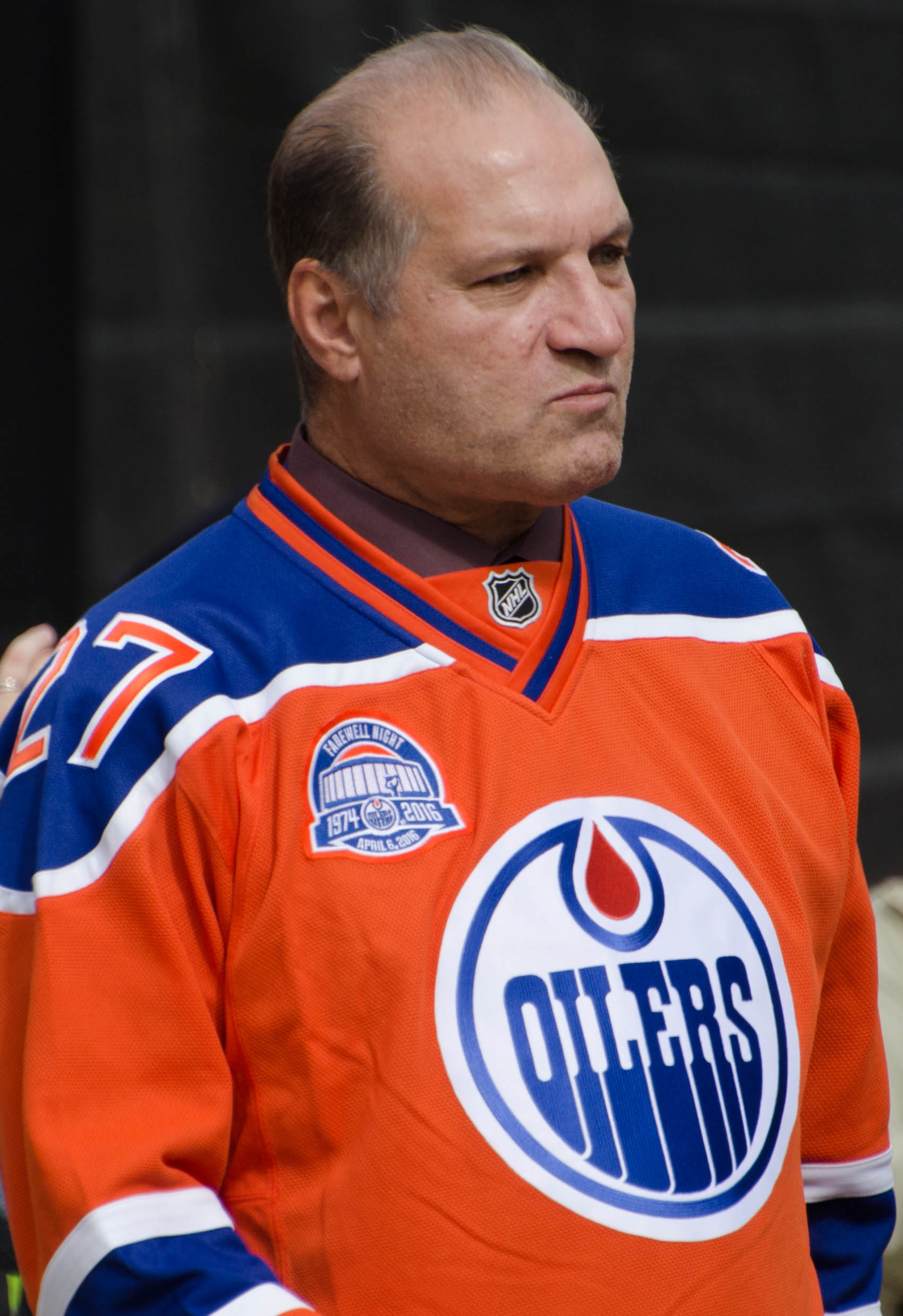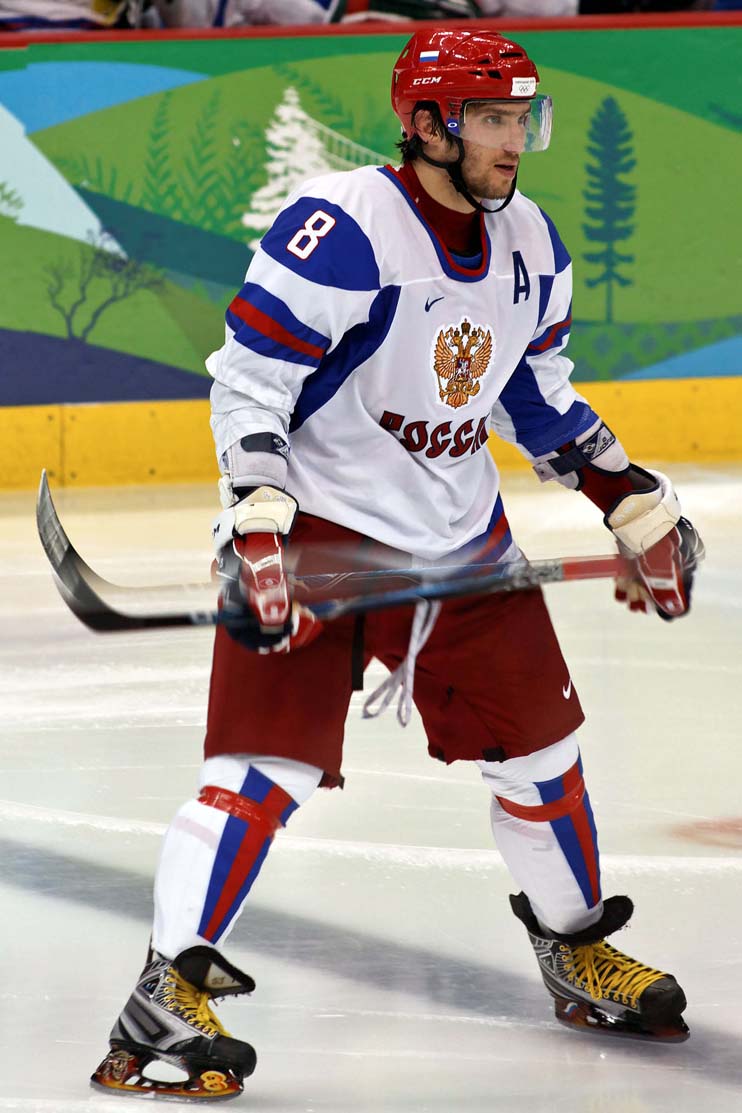|
Willi Plett
Willi Plett (born June 7, 1955) is a Paraguayan-born Canadian former professional ice hockey right winger who played 834 games in the National Hockey League (NHL) for the Atlanta Flames, Calgary Flames, Minnesota North Stars and Boston Bruins. He was a fifth-round selection of the Atlanta Flames in the 1975 NHL Amateur Draft, 80th overall. Plett was a member of the Tulsa Oilers' Adams Cup championship team in 1975–76 and won the Calder Memorial Trophy in 1977 as the NHL's top rookie. He transferred with the Flames franchise to Calgary in 1980 and a 1982 trade sent him to Minnesota where he played five seasons. Plett retired in 1988 following one season in Boston. Early life Plett was born into a "Russian" Mennonite family who had lived in the Soviet Union and then Germany and fled to South America to escape the Second World War. They settled in Asunción, Paraguay, where he was born on June 7, 1955. His family moved to Canada one year later, settling in Niagara-on-the-Lake, ... [...More Info...] [...Related Items...] OR: [Wikipedia] [Google] [Baidu] |
Minnesota North Stars
The Minnesota North Stars were a professional ice hockey team in the National Hockey League (NHL) for 26 seasons, from 1967 to 1993. The North Stars played their home games at the Met Center in Bloomington, Minnesota, and the team's colors for most of its history were green, yellow, gold and white. The North Stars played 2,062 regular season games and made the NHL playoffs 17 times, including two Stanley Cup Finals appearances, but were ultimately unable to win the Stanley Cup. After the 1992–93 season, the franchise moved to Dallas, and is now known as the Dallas Stars. History Beginnings On March 11, 1965, NHL President Clarence Campbell announced that the league would expand to twelve teams from six through the creation of a new six-team division for the 1967–68 season. In response to Campbell's announcement, a partnership of nine men, led by Walter Bush, Jr., Robert Ridder, and John Driscoll, was formed to seek a franchise for the Twin Cities area of Minnesota. Thei ... [...More Info...] [...Related Items...] OR: [Wikipedia] [Google] [Baidu] |
Niagara-on-the-Lake
Niagara-on-the-Lake is a town in Ontario, Canada. It is located on the Niagara Peninsula at the point where the Niagara River meets Lake Ontario, across the river from New York, United States. Niagara-on-the-Lake is in the Niagara Region of Ontario and is the only town in Canada that has a lord mayor."Oh, Lordy!; Niagara-on-the-Lake's mayor is the only one in Canada referred to as 'lord,' but as reporter Monique Beech discovered, the title's official status isn't clear" . '' [...More Info...] [...Related Items...] OR: [Wikipedia] [Google] [Baidu] |
1977–78 NHL Season
The 1977–78 NHL season was the 61st season of the National Hockey League. The Montreal Canadiens won their third Stanley Cup in a row, defeating the Boston Bruins four games to two in the Stanley Cup Finals. League business Prior to the start of the season, Clarence Campbell retired as NHL President. John Ziegler succeeded him in that capacity. A trophy for the top defensive forward, the Frank J. Selke Trophy, made its debut this season and went to Bob Gainey, who played left wing for Montreal. On June 14, 1978, the league approved the merger of the financially struggling Cleveland Barons and Minnesota North Stars franchises, reducing the number of teams to 17, with the North Stars (now the Dallas Stars) assuming the Barons' place in the Adams Division. It was the first instance of a franchise dissolving since the Brooklyn Americans ceased operations in 1942. The next time the NHL had a team in Ohio would be the expansion Columbus Blue Jackets in the 2000–01 season. The ... [...More Info...] [...Related Items...] OR: [Wikipedia] [Google] [Baidu] |
Penalty (ice Hockey)
A penalty in ice hockey is a punishment for an infringement of the rules. Most penalties are enforced by sending the offending player to a penalty box for a set number of minutes. During the penalty the player may not participate in play. Penalties are called and enforced by the referee, or in some cases, the linesman. The offending team may not replace the player on the ice (although there are some exceptions, such as fighting), leaving them short-handed as opposed to full strength. When the opposing team is said to be on a ''power play'', they will have one more player on the ice than the short-handed team. The short-handed team is said to be "on the penalty kill" until the penalty expires and the penalized player returns to play. While standards vary somewhat between leagues, most leagues recognize several common varieties of penalties, as well as common infractions. The statistic used to track penalties is called "penalty minutes" and abbreviated to "PIM" (spoken as single w ... [...More Info...] [...Related Items...] OR: [Wikipedia] [Google] [Baidu] |
Goal (ice Hockey)
In ice hockey, a goal is scored when the puck entirely crosses the goal line between the two goal posts and below the goal crossbar. A goal awards one point to the team attacking the goal scored upon, regardless of which team the player who actually deflected the puck into the goal belongs to (see also own goal). Typically, a player on the team attempting to score shoots the puck with their stick towards the goal net opening, and a player on the opposing team called a goaltender tries to block the shot to prevent a goal from being scored against their team. The term goal may also refer to the structure in which goals are scored. The ice hockey goal is rectangular in shape; the front frame of the goal is made of steel tube painted red (blue in the ECHL because of a sponsorship deal with GEICO) and consists of two vertical goalposts and a horizontal crossbar. A net is attached to the back of the frame to catch pucks that enter the goal and also to prevent pucks from entering it ... [...More Info...] [...Related Items...] OR: [Wikipedia] [Google] [Baidu] |
Orland Kurtenbach
Orland John Kurtenbach (born September 7, 1936) is a Canadian former professional ice hockey player and coach. A centre notable for his defensive skill and as one of the toughest fighters in the game, he played for several National Hockey League (NHL) teams during his twenty professional seasons, principally the Vancouver Canucks, with whom he became the NHL franchise's inaugural captain. Early life Kurtenbach was born in Cudworth, Saskatchewan. He grew up on a farm until his family moved to Prince Albert, Saskatchewan, at age 10. It was at this time that Kurtenbach began playing organized hockey. Beginning as a defenceman, he moved to the centre position later in his career. Playing career Kurtenbach played in the Saskatchewan Junior Hockey League (SJHL) with the Prince Albert Mintos for two seasons, also making brief appearances with the Saskatoon Quakers of the minor professional Western Hockey League (minor pro), Western Hockey League (WHL) during that time. In 1957, after Pr ... [...More Info...] [...Related Items...] OR: [Wikipedia] [Google] [Baidu] |
Enforcer (ice Hockey)
Enforcer is an unofficial role in ice hockey. The term is sometimes used synonymously with "fighter", "tough guy", or "goon". An enforcer's job is to deter and respond to dirty or violent play by the opposition. When such play occurs, the enforcer is expected to respond aggressively, by fighting or checking the offender. Enforcers are expected to react particularly harshly to violence against star players or goalies. Enforcers are different from pests, players who seek to agitate opponents and distract them from the game, without necessarily fighting them. The pest's primary role is to draw penalties from opposing players, thus "getting them off their game", while not actually intending to fight the opposition player (although exceptions to this do occur). Pests and enforcers often play together on the same line, usually the fourth line. National Hockey League At present in the National Hockey League (NHL), teams generally do not carry more than one player whose primary role is ... [...More Info...] [...Related Items...] OR: [Wikipedia] [Google] [Baidu] |
Central Hockey League (1963–1984)
The Central Professional Hockey League was a minor professional ice hockey league that operated in the United States from 1963 to 1984. Named the Central Hockey League for the 1968–69 season and forward, it was owned and operated by the National Hockey League and served as a successor to the Eastern Professional Hockey League, which had folded after the 1962–63 season. Four of the CHL's initial franchises were, in fact, relocations of the previous year's EPHL teams, while the fifth came from the International Hockey League. Its founding president was Jack Adams, who served in the role until his death in 1968. The CHL's championship trophy was called the Adams Cup in his honor. History In the league's first season, all five teams were affiliated with an NHL club. The CHL initially consisted of the Indianapolis Capitals ( Detroit Red Wings), Minneapolis Bruins (Boston Bruins), Omaha Knights (Montreal Canadiens), St. Louis Braves (Chicago Black Hawks) and the St. Paul Ra ... [...More Info...] [...Related Items...] OR: [Wikipedia] [Google] [Baidu] |
Fighting In Ice Hockey
Fighting is an established tradition in North American ice hockey, with a long history that involves many levels of amateur and professional play and includes some notable individual fights. Fights may be fought by enforcers, or "goons" ()—players whose role is to fight and intimidate—on a given team, and are governed by a system of unwritten rules that players, coaches, officials, and the media refer to as "the code". Some fights are spontaneous, while others are premeditated by the participants. While officials tolerate fighting during hockey games, they impose a variety of penalties on players who engage in fights. Unique among North American professional team sports, the National Hockey League (NHL) and most minor professional leagues in North America do not eject players outright for fighting (although they may do so for more flagrant violations as part of a fight) but major European and collegiate hockey leagues do, and multi-game suspensions may be added on top of ... [...More Info...] [...Related Items...] OR: [Wikipedia] [Google] [Baidu] |
Power Forward (ice Hockey)
In ice hockey, power forward (PWF) is a loosely applied characterization of a forward who is big and strong, equally capable of playing physically or scoring goals and would most likely have high totals in both points and penalties. It is usually used in reference to a forward who is physically large, with the toughness to dig the puck out of the corners, possesses offensive instincts, has mobility, puck-handling skills, may be difficult to knock off the puck or to push away from the front of the goal and willingly engage in fights when he feels it is required. Possessing both physical size and offensive ability, power forwards are also often referred to as the 'complete' hockey player. Historically, ''power forward'' was not originally a hockey term, finding comparatively recent origins from basketball. Harry Sinden, former president of the Boston Bruins, claims ''power forward'' first became part of hockey terminology because of the style of play of Cam Neely, an NHL player from ... [...More Info...] [...Related Items...] OR: [Wikipedia] [Google] [Baidu] |
Niagara Falls Flyers (1972–1976)
The Niagara Falls Flyers were a Tier II Junior "A" ice hockey team and member of the Southern Ontario Junior A Hockey League. The team played home games at the Niagara Falls Memorial Arena in Niagara Falls, Ontario. History In 1972, the Ontario Hockey Association's Tier I Junior "A" Niagara Falls Flyers were sold and relocated to Sudbury, Ontario as the Sudbury Wolves. They were replaced in Niagara Falls by the Tier II Flyers the same year. They played four season in the Southern Ontario Junior A Hockey League. In 1976, the Tier II Flyers made way for the St. Catharines Black Hawks who were relocated as the second incarnation of the Tier I Niagara Falls Flyers. Season-by-Season results Playoffs *1973 ''Lost quarter-final'' :Windsor Spitfires defeated Niagara Falls Flyers ''4-games-to-3'' *1974 ''Lost quarter-final'' : Welland Sabres defeated Niagara Falls Flyers ''4-games-to-1'' *1975 ''Lost quarter-final'' :Chatham Maroons defeated Niagara Falls Flyers ''4-games-to-1 with 1 ... [...More Info...] [...Related Items...] OR: [Wikipedia] [Google] [Baidu] |
Hap Emms
Leighton Alfred Emms (January 12, 1905 – October 23, 1988) was a Canadian ice hockey player, coach, team owner, and general manager, during nearly 60 years in hockey. Emms played 17 seasons of professional hockey as a left winger and a defenceman, including 10 seasons and 320 games in the National Hockey League. After playing, Emms had a 33-year presence in the Ontario Hockey Association, as the owner of the Barrie Flyers, Niagara Falls Flyers, and St. Catharines Black Hawks between 1945 and 1978. Teams that Emms coached or owned appeared in eight Memorial Cup tournaments, winning four Memorial Cups. He was nicknamed "Happy Emms" due to the sour look on his face, which was later shortened to "Hap Emms". Playing career Emms started his career as a left winger playing junior ice hockey from 1921 to 1925. He signed as a free agent with the Montreal Maroons on November 10, 1926. He spent the next two seasons splitting time between the Maroons and the Stratford Nationals of the Can ... [...More Info...] [...Related Items...] OR: [Wikipedia] [Google] [Baidu] |






